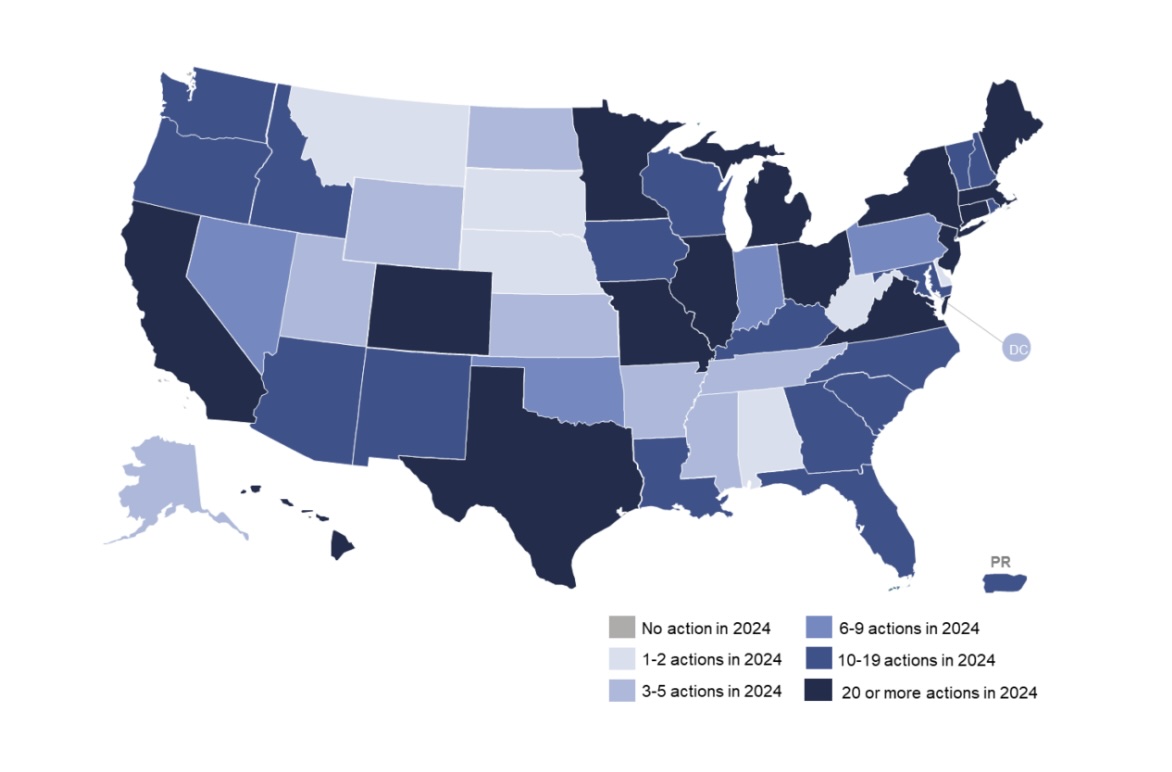The 50 States of Grid Modernization: States Advance Integrated Distribution System Planning and Grid Flexibility in 2024
The N.C. Clean Energy Technology Center (NCCETC) released its 2024 annual review and Q4 2024 update edition of The 50 States of Grid Modernization. The quarterly series provides insights on state regulatory and legislative discussions and actions on grid modernization, utility business model and rate reforms, energy storage, microgrids, and demand response.
The report finds that all 50 states, plus DC and Puerto Rico, took actions related to grid modernization during 2024 (see figure below), with the greatest number of actions relating to energy storage deployment, utility business model reforms, interconnection rules, performance-based regulation, and distribution system planning rules.
2024 State and Utility Action on Grid Modernization

The report highlights ten of the top grid modernization trends of 2024:
- Establishing distribution system planning guidelines;
- Evaluating opportunities for grid-enhancing technologies;
- Investigating and creating state frameworks for virtual power plants;
- Developing expansive grid investment plans;
- Examining performance-based regulation tools;
- Moving toward incentive programs with active control or performance incentives;
- Piloting advanced time-varying rate designs;
- Planning for long-duration battery storage deployment;
- Implementing cost sharing for interconnection-related grid upgrades; and
- Undertaking resilience-focused grid planning.
“In 2024, several states solidified significant plans for energy storage procurement,” observed Justin Lindemann, Policy Analyst at NCCETC. “Various states unveiled ambitious proposals and targets to enhance grid storage capacity in the Northeast, with Massachusetts announcing a new goal of 5 GW by mid-2030 and New York regulators establishing a framework to achieve a 6 GW storage target by 2030.”
A total of 822 grid modernization actions were taken during 2024. The report notes that ten of the most active states in 2024 for grid modernization were:
- Colorado, where lawmakers enacted virtual power plant legislation and regulators considered performance-based regulation measures and Xcel Energy’s distribution system plan;
- New Jersey, where the Board of Public Utilities addressed virtual power plants, data access, integrated distribution system planning and an energy storage incentive program;
- New York, where regulators opened a new “Grid of the Future” proceeding and approved a new energy storage roadmap, while utilities proposed a proactive grid planning framework;
- Massachusetts, where the Department of Public Utilities approved utilities’ electric sector modernization plans and legislators increased the state’s energy storage target;
- Connecticut, where regulators took steps advancing performance incentive mechanisms, non-wires solutions, interconnection, and integrated distribution system planning;
- Minnesota, where Xcel Energy proposed a new distributed capacity procurement, while regulators began proceedings on integrated distribution planning and advanced rate design;
- California, where regulators opened a new proceeding focused on grid resilience and adopted distribution system planning process improvements;
- Maryland, where legislators enacted a bill requiring the development of a virtual power plant program, while a work group proposed recommendations distribution system planning ;
- Illinois, where regulators approved utilities’ integrated grid plans and the Illinois Power Agency completed an energy storage policy study; and
- Michigan, where regulators considered distribution system planning modifications and worked to implement the new state’s energy storage target.
“This year has featured an increase in regulator and utility action regarding plans for electric distribution systems in their jurisdictions." noted Vincent Potter, Policy Project Manager at NCCETC, "Enhanced distribution system plans include grid modernization technologies like automated management systems, DER management systems, and non-wires alternatives to infrastructure expansion. These plans tend to support distributed resource deployments and aggregations (i.e. virtual power plants), and also can improve reliability, resiliency, and efficiency of the grid.”
In Q4 2024, 47 states, plus DC and Puerto Rico, took some type of action on distributed solar policy or rate design. A total of 502 actions were tracked in Q4.
NC Clean Energy Technology Center | www.nccleantech.ncsu.edu








